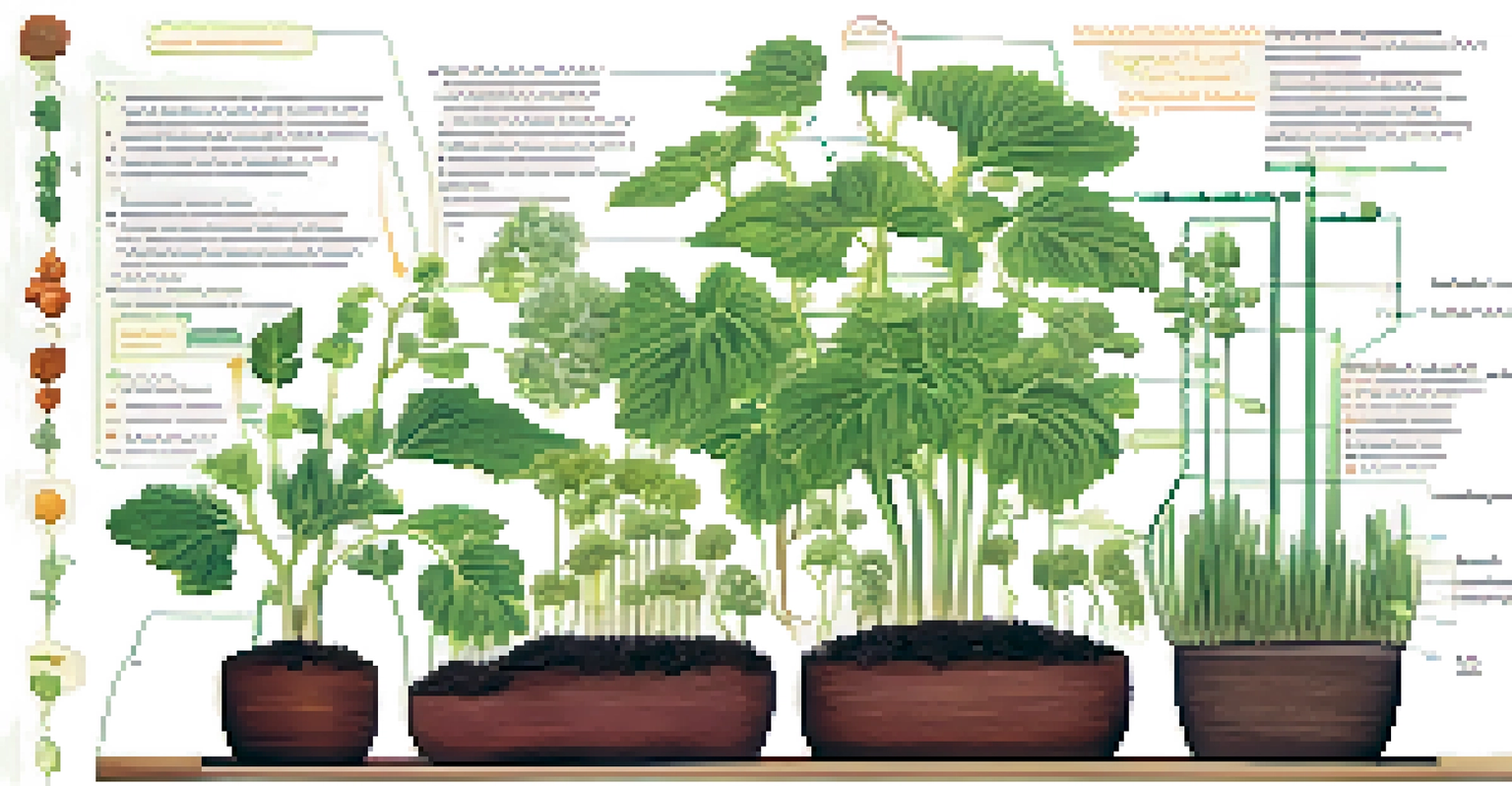The Role of Hormones in Plant Growth and Environmental Response

What Are Plant Hormones and Their Functions?
Plant hormones, also known as phytohormones, are chemical messengers that regulate various aspects of plant growth and development. These hormones can influence processes such as cell division, elongation, and differentiation. The five main types of hormones include auxins, gibberellins, cytokinins, abscisic acid, and ethylene, each playing a unique role in plant physiology.
Plants are like people. They need to be nurtured and cared for, and they can be made to thrive when the right conditions are created.
For example, auxins are primarily responsible for promoting stem elongation, while cytokinins encourage cell division. This delicate balance of hormones ensures that plants can grow and adapt effectively to their environment. By understanding how these hormones function, we can better appreciate the intricate processes behind plant development.
In essence, plant hormones act like conductors in an orchestra, coordinating various growth processes to create a harmonious development cycle. Without these hormones, plants would struggle to thrive, just as musicians would falter without a conductor.
Auxins: The Growth Regulators
Auxins are perhaps the most well-known plant hormones, primarily involved in promoting cell elongation and growth. They are produced in the tips of shoots and roots, and their concentration affects how plants respond to stimuli, such as light and gravity. This phenomenon is known as tropism, where plants grow toward light (phototropism) or down into the soil (gravitropism).

For instance, if a plant is leaning toward a window, it's because auxins are accumulating on the shaded side, causing that side to grow faster and ultimately resulting in a straightening of the plant toward the light. This ability to adapt to environmental cues is crucial for a plant's survival and growth.
Plant Hormones Shape Growth
Plant hormones, or phytohormones, are essential chemical messengers that regulate crucial processes like growth, development, and adaptation in plants.
Overall, auxins are like the steering wheel of a car, guiding the plant's growth direction and helping it navigate its surroundings effectively. Their regulation is vital for optimizing light capture and anchoring roots into the soil, ensuring overall plant health.
Gibberellins: The Growth Promoters
Gibberellins are another essential class of plant hormones that play a significant role in promoting growth and development. They are particularly known for stimulating seed germination and breaking dormancy, allowing seeds to sprout when conditions are favorable. When a seed absorbs water, gibberellins are activated, leading to the growth of the embryo and the emergence of the plant.
Nature is a laboratory, and we are its students. We learn from plants how to adapt and survive in varying conditions.
Additionally, gibberellins influence stem elongation and flowering, making them crucial for plant height and reproductive success. For example, certain agricultural practices harness gibberellins to produce larger fruits and vegetables, enhancing crop yields.
Think of gibberellins as the motivational coach for plants, encouraging them to grow taller and stronger. By understanding their role, we can utilize these hormones to optimize agricultural practices, ultimately benefiting food production and sustainability.
Cytokinins: The Cell Division Champions
Cytokinins are hormones that primarily promote cell division and growth in plants. They are produced in various plant tissues, including roots, and are transported to other parts of the plant, where they stimulate cell division and differentiation. Their presence is crucial for the development of new shoots and leaves, as well as for delaying leaf senescence.
One of the fascinating aspects of cytokinins is their role in balancing growth with other hormones. For instance, while auxins promote root growth, cytokinins encourage shoot development, ensuring a well-rounded growth process. This balance is essential for the overall health and vitality of the plant.
Hormonal Interactions Matter
The interplay between different plant hormones ensures a balanced growth response, crucial for healthy development and environmental adaptation.
In a way, cytokinins serve as the supportive team members in a sports game, working alongside other hormones to ensure that all parts of the plant are developing cohesively. Their contribution is vital for the plant's ability to thrive and adapt in its environment.
Abscisic Acid: The Stress Manager
Abscisic acid (ABA) is often referred to as the stress hormone in plants, playing a critical role in helping plants respond to adverse conditions. For example, during drought, ABA levels increase, prompting the plant to close its stomata, reducing water loss and conserving moisture. This response is vital for survival in challenging environments.
Additionally, ABA is involved in seed dormancy, ensuring that seeds only germinate under favorable conditions. By regulating water usage and timing of germination, ABA helps plants endure periods of stress while maximizing their growth potential when conditions improve.
Think of abscisic acid as the plant's emergency response team, activated during times of crisis. Its ability to manage stress effectively allows plants to survive in fluctuating environments, making it a key player in their resilience.
Ethylene: The Ripening and Aging Hormone
Ethylene is a unique plant hormone known for its role in the ripening of fruits and the aging process of plants. It is a gaseous hormone, which means it can diffuse through the air and affect nearby plants. Ethylene production increases as fruits ripen, leading to the characteristic changes in color, texture, and flavor that we associate with ripe fruit.
Moreover, ethylene plays a significant role in processes like leaf abscission, where leaves fall off to conserve resources. This is particularly important for deciduous trees, which shed their leaves in response to seasonal changes. Understanding ethylene's role helps us in agriculture, especially in post-harvest management.
Agricultural Benefits of Hormones
Understanding and manipulating plant hormones can significantly enhance agricultural practices, leading to improved crop yields and resilience against environmental stressors.
In a way, ethylene acts like a signal flare, marking the transition from growth to maturity. Its influence on ripening and aging highlights the dynamic nature of plant life, reminding us that growth isn't just about getting taller or producing more leaves—it's also about preparing for the next stages of life.
Hormonal Interactions: The Balancing Act
The interactions between different plant hormones create a complex network that regulates growth and development. Each hormone does not work in isolation but rather interacts with others to produce a balanced response to environmental stimuli. For example, auxins and cytokinins work together to promote cell division while maintaining proper growth patterns.
This delicate balance is crucial because an imbalance in hormone levels can lead to various growth issues, such as stunted growth or uncontrolled cell division. Understanding these interactions allows scientists and farmers to manipulate hormone levels for desired outcomes in plant health and yield.

Think of hormonal interactions as a well-choreographed dance, where each dancer has a role that contributes to the overall performance. The harmony between these hormones is essential for plants to adapt and thrive in their environments, highlighting the intricate beauty of nature.
Applications of Plant Hormones in Agriculture
Understanding the role of plant hormones has significant implications for agriculture and horticulture. By manipulating hormone levels, farmers can enhance crop growth, improve fruit quality, and increase yields. For instance, applying gibberellins can lead to larger fruits, while cytokinins can delay leaf aging, ensuring that crops remain healthy longer.
Moreover, the strategic use of hormones can help in overcoming environmental challenges, such as drought or pest infestations. For example, applying abscisic acid can increase a plant's tolerance to water stress, allowing crops to thrive even in less-than-ideal conditions.
In essence, the applications of plant hormones in agriculture are like having a toolkit at your disposal, enabling farmers to optimize their practices and produce healthier crops. By understanding and utilizing these hormones, we can contribute to sustainable farming and food security, benefiting both people and the planet.